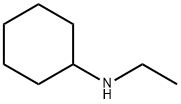Chemical Properties
Clear colorless liquid
Uses
Intermediate in production of herbicides and
pharmaceuticals.
Uses
N-Ethylcyclohexylamine can be used in the synthesis of a series of isatin-N-Mannich bases.
Production Methods
N-Ethylcyclohexylamine is produced by hydrogenation of ethylaniline at 180 ℃ and 6 MPa or by amination of cyclohexanone under hydrogenation conditions in the presence of ethylamine. The amine is a starting material for the preplant sugar beet, grass, and spinach herbicide cycloate (Zeneca's Ro-Neet), which is obtained by converting N-ethylcyclohexylamine into S-ethyl-N-ethyl-N-cyclohexylthiocarbamate. A minor use of N-ethylcyclohexylamine is for vulcanization accelerators.
General Description
A clear colorless liquid with an ammonia-like odor. Floats on water and slightly soluble in water. Vapors heavier than air. Produces toxic oxides of nitrogen during combustion.
Air & Water Reactions
Highly flammable. Slightly soluble in water.
Reactivity Profile
N-Ethylcyclohexylamine neutralizes acids in exothermic reactions to form salts plus water. May be incompatible with isocyanates, halogenated organics, peroxides, phenols (acidic), epoxides, anhydrides, and acid halides. Flammable gaseous hydrogen may be generated in combination with strong reducing agents, such as hydrides.
Hazard
Corrosive and toxic.
Health Hazard
Inhalation of high concentration of vapor will produce irritation of the respiratory tract and lungs. Inhalation of large quantities of vapor may be fatal.
Fire Hazard
Behavior in Fire: Dangerous when exposed to heat or flame. Can react vigorously with oxidizing materials.
Safety Profile
Moderately toxic by
ingestion, inhalation, and skin contact. A
severe skin and eye irritant. A very
dangerous fire hazard when exposed to heat
or flame; can react vigorously with oxidizing
materials. To fight fKe, use alcohol foam,
mist, spray, dry chemical. See also AMINES






